In a comprehensive interview with The Worldfolio, Shusuke Chino, President of Ziosoft discusses the evolution of the company from its computer science roots in 1998 to a pioneering force in medical imaging and digital transformation. Addressing Japan's healthcare challenges, Chino emphasizes the role of digital technologies in enhancing efficiency for an aging society. He explores Ziosoft's innovative products, such as Ziostation REVORAS, detailing their impact on workflows and patient care. Touching on the integration of AI, Chino highlights Ziosoft's commitment to streamlining processes while considering the unique challenges of the healthcare sector. The conversation also delves into market dynamics, regulatory adaptations, and global expansion plans, with Chino envisioning a future where Ziosoft continues to advance medical imaging technologies for the benefit of healthcare professionals and patients alike.
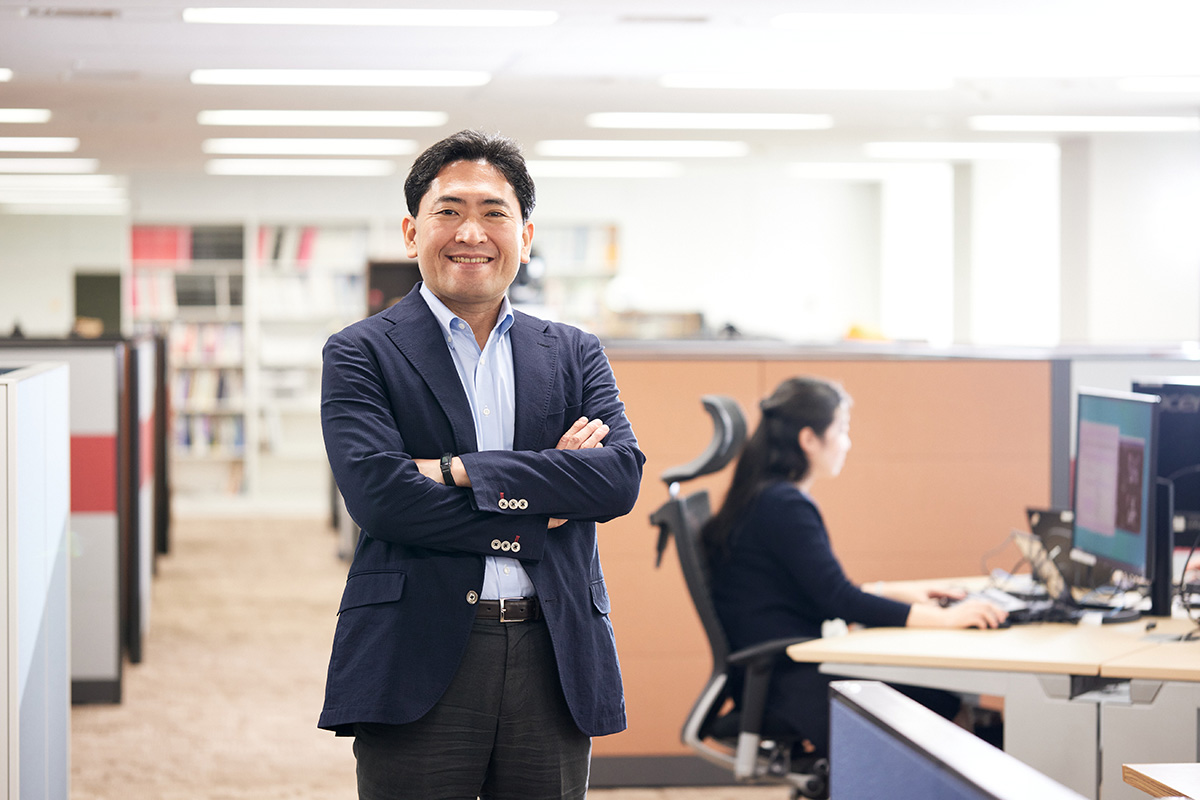
If we could start with a quick introduction to your company. What is Ziosoft's main business and what are some important milestones in the establishment of your company?
I remember the day we established the company very well because it was quite a hot summer season back in 1998. We started with only 4 engineers including myself and those people did not have a medical background. Those engineers had learned about computer science and technologies, so to some extent we had a little insight into medical software, but the initial idea behind the company was as a computer science business. Based on the technology that was around at the time, one of the areas that interested us the most was medical imaging, and at that time we believed that in this area, we could make contributions to society.
If you look back at that era there were a lot of cell phone games that were popular. Of course, entertainment is an interesting area but there are more meaningful solutions that we could discover as a company. This is why we put our competence into the medical field. I believe that this catalyst was a great starting point for the 25 years we've experienced so far at Ziosoft.
Japan is known to be the oldest society in the world, and the demographic situation right now is putting a lot of pressure on public finances. Social security expenses have soared since 2019, and as such the Japanese government is shifting its healthcare model from treatment to a prevention-based solution. What are your thoughts on the current state of Japan's health care system and what digital technologies do you believe could help with the rollout of this prevention model?
First of all, that is a very good question, and the landscape is a little bit different from our own business. Generally, I believe that DX will make workflows more efficient, which I believe will benefit the aging society in Japan, especially in a hospital setting. Many people work in hospitals and there is a need for efficient communication, so there is a lot of room for improvement in that regard. Also, however, I understand that this is a very personal opinion, Japanese people live in a culture that is very detail-oriented and each person does their best to follow the rules to the letter. No Japanese person would ever dare to sabotage something, which also means there are little to no compromises made. It is a bit of a double-edged sword at times, and could certainly prevent the introduction of new digital solutions, which is sometimes not following the existing word-for-word rules.
As a baseline, I believe that the kind of medical imaging that we do and digital imaging as a whole is a very unique technology. There is no other device that allows us to look inside a patient so precisely and one of the key points is that it does so non- or minimally invasively. I would like to expand the applications of medical imaging to not only radiology but also clinical divisions. We are providing the technology needed to accelerate this.
Although staff in hospitals are doing their best to get the most out of the medical equipment they have, they still need newer technologies to accelerate or streamline their workflow. This is a point that we focus on.
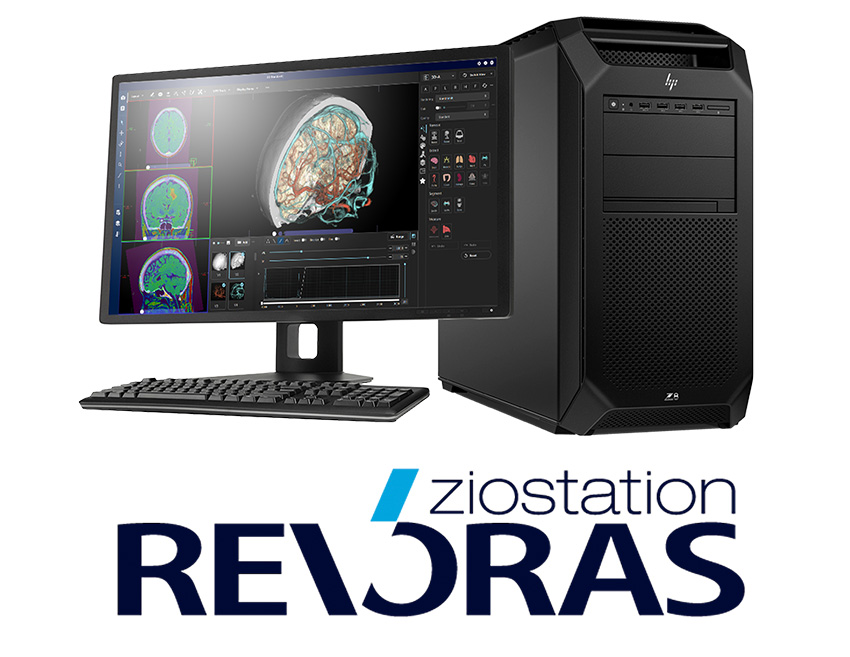
Ziostation REVORAS: Offers numerous productivity improvements and enhanced visualization technology, including photorealistic Ziosoft Rembrandt image rendering. This superb image rendering capability is designed to dramatically transform or reimagine 3D medical image viewing.
A survey conducted by a Health Ministry research team this year revealed that around 20% of doctors in Japan are at risk of death from overwork, with full-time doctors working roughly 60 hours per week. To address these digital and AI-based solutions are being introduced to assist these medical professionals. As you mentioned, Ziosoft's products are used to reduce the burden of users in various clinical departments such as radiology. Can you go into more detail and explain the technology and the solutions that you provide and how they can alleviate the burden placed on these medical professionals?
We consider two major impacts as a result of our services. Firstly there is a smoother workflow to streamline operations for hospitals, and this is something we hope will soon enable new concepts and methods for patient care. Much research regarding diagnosis using medical images is conducted by academic societies but generally, it takes time and resources in the first place. With our software, those techniques can be applied to real-world practice, by supporting manual steps to complete the procedure or automating the compilation of the diagnostic result. We are proud that this is something we can contribute to the health care of the public. Another aspect is the new clinical value we can provide, by implementing novel methods of diagnosis or visualization based on collaboration with such state-of-the-art research institutes.
Do you have any examples of those new clinical values or quantifications you spoke of?
Take a colonoscopy, for example, it is an invasive procedure where a doctor will place a camera inside the patient using an endoscope. Japan is one of the first countries to develop CT colonography, also known as virtual colonoscopy, which uses low-dose radiation CT scanning to obtain an interior view of the colon. Our CT Colon Analysis feature of the Ziostation system was developed in collaboration with a known medical institute in Japan. You have to remember that this sort of imaging simply cannot be done without robust software on the back end. Our solutions enable that practice in real life.
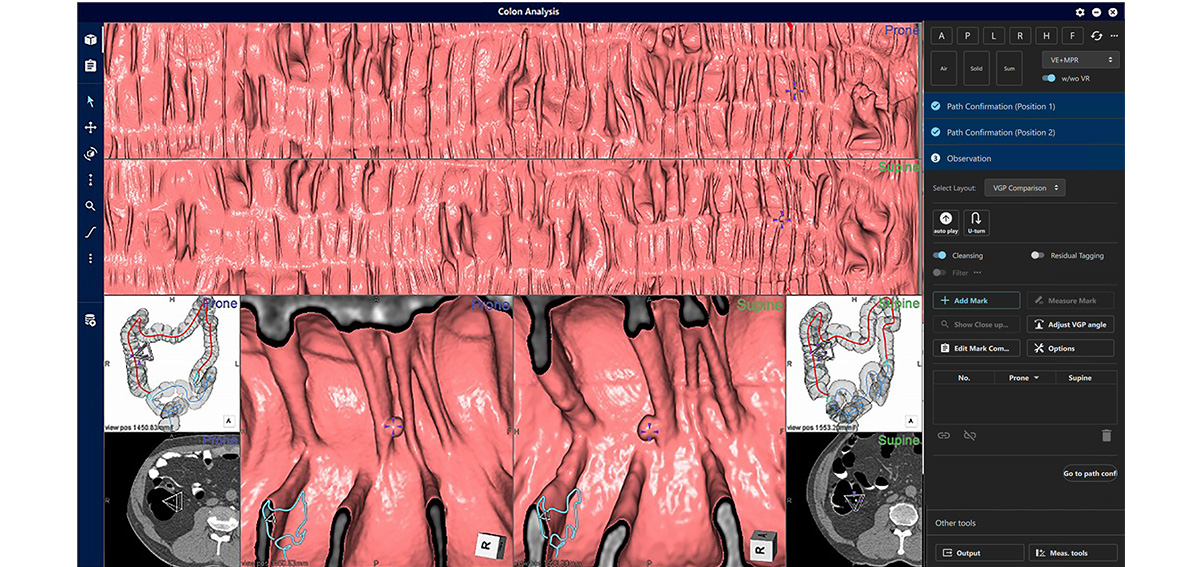
CT Colon Analysis: Automatically extracts the colon and displays the results in Virtual Gross Pathology (VGP) and virtual endoscopy views.
If we talk about minimally invasive treatments, one of the older aspects is minimally invasive surgeries, where a micro-hole allows surgeons to operate. In the case of your imaging, is yours conducive to those types of operations?
Let's take lung cancer as an example. The lung can be divided into five lobes and an operation called lobectomy – taking a lobe wholly – has been popular. There is a new technique being developed called segmentectomy, where the surgeon will just cut an anatomical part of the lobe, but to conduct this complicated operation surgeons need to understand the structure of the lung vessel; the information on the patient is vital to do such a precise surgery. That’s what our latest product, Ziostation REVORAS can provide. With a better view of the patient before surgery, the doctors can do their job to a more efficient degree. I spoke with some American medical professionals in May 2023 at the annual meeting of AATS(The American Society for Thoracic Surgery) and they said they need the kind of application we are providing to do this segmentectomy.
Japanese doctors seem to be taking a great role in leading this newer technique, and from my understanding Japanese doctors in general are very keen on minimal invasive techniques and the pursuit of more precise operations. We have great collaborations with those doctors and we can further develop our applications.
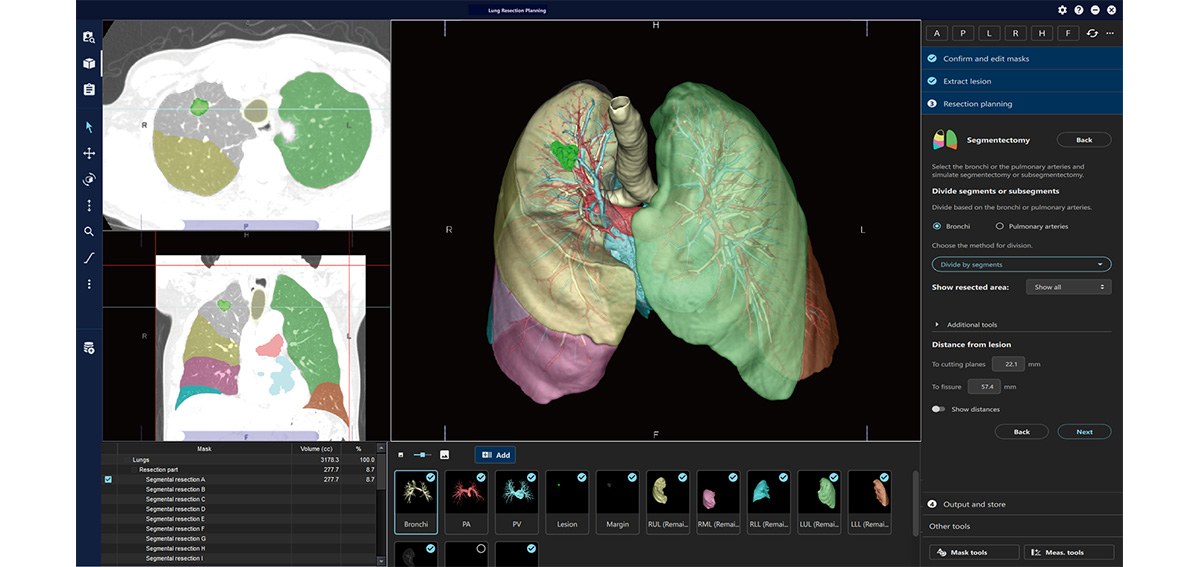
CT Lung Analysis: High-precision automatic segmentation of lungs, lung lobes, bronchi, pulmonary arteries, and veins enables lung resection proposals based on bronchial or arterial anatomy.
Now that you’re automating a lot of processes using AI is there a risk that you’re making it too easy for doctors? If you give them the answer rather than have them figure it out themselves there is always the danger that they don’t develop the skills needed to identify issues with patients. Could you comment on this hypothesis?
That is a very good question, and I’m sure you are aware that we are seeing the emergence of robotic surgeries in recent years. Laparoscopic surgery seems generally difficult for even skilled doctors to do, and surgical robots seem to give support for it. I heard that some young doctors are now learning how to do these robotic surgeries from the get-go. This will increase the number of minimally invasive surgery in the long term.
Think about a car now in 2023. Drivers use navigation systems that give them guidance and EVs don’t even have transmissions, so drivers don’t need to worry about changing gears. I think the same sort of analogy works here with minimally invasive surgery through robotics. I like to think of automation as the automatic gearbox and guidance system for surgeons. Some might complain that people these days don’t even learn to drive manual vehicles, but I think we are still going to be driving vehicles and in my opinion, an automatic allows drivers to concentrate on other things involved in driving since they don’t need to worry about changing gears.
AI technologies and robotics are a big jump. In August 2023 Microsoft CEO Satya Nadella claimed that AI will be the next tidal wave of innovation after the internet. This year the tech giant rolled out its AI assistant Copilot directly in programs such as its Office 365 suite, and it is predicted that Copilot will reach about 6.9 million US knowledge workers in 2024. Firms such as AIM have created the world’s first AI that can detect early gastrointestinal (GI) cancer with a 90% success rate. What challenges and opportunities does AI present your firm? What are your thoughts on AI and its effectiveness within medical practices?
My opinion is that the healthcare industry is a little different and unique compared to the general IT industry. ChatGPT and other language models answer in long-form text, something that doesn’t apply in the medical field itself. I know that there are companies out there working on diagnosis to replace human doctors but right now we are in this sort of transitional phase between conventional diagnosis and new diagnosis. Ziosoft is currently focused on how to streamline workflow and how to give doctors more detailed information about their patients. I think these processes will gradually transfer to automated processes.
The medical sector is typically slow in transition to these new technologies since it is such a sensitive area and you still need a human aspect. Even for autonomous driving cars, we’ve seen advancements for around 10 years now, but even in 2023, we’ve yet to see significant implementations. Right now it is in limited areas, but sooner or later it will come and we would like to be a part of that. The medical sector will follow later.
The unique aspect of health care is that when it comes to each country, there are individual rules and regulations, and Ziostation is a certified medical device software package that has a top market share in Japan. However, Japan’s certifications and regulations are different from other countries like the US where you have a presence. How have you been able to adapt your products to suit the different regulations of the US market?
This is an area where we put effort into adapting. Part of the process can be common but other parts are not. Also the regulations for the reimbursement systems there are different, so some treatments that would be reimbursed in Japan won’t be in the US. Another big thing you have to remember is the insurance systems in place, which differ wildly between Japan and the United States. Japan has universal health care, but America doesn’t yet have a lot of private insurance companies. Such difference affects our business strategy.
How will you adapt to these regulations? Will you utilize local partnerships?
It depends from region to region, but partnerships are dependent on the product activities. Of course, in developing that software we do need to hear the opinions of different territories and the actual needs of customers so that we can accurately reflect what is needed in our product. In that sense, partnerships are very important to our business model. I sometimes forget how difficult the medical business is and how many stakeholders are involved.
Take a hospital for example, just within one building there are so many different stakeholders, each with their own priorities. Perhaps something that doctors feel will be beneficial might not fit into the budget, and therefore the administration doesn’t see the benefits. Dealing with hospitals in our line of work is crucial, so therefore communication and collaboration are a necessity. We need to be on the cutting edge of technological innovations so therefore collaborations are very important.
On the topic of R&D are there any new technologies or breakthroughs that you would like to share with us today?
The big focus is on that segmentectomy for lung cancer I talked about earlier. With our product Ziostation REVORAS, this entire process is automated and quite beneficial for surgeons. Its capability is not limited to lung cancer.
Ziosoft USA is based in California where Silicon Valley is based with big tech like Google, Apple, Facebook, and Amazon. Why did you choose the United States as the location for your first overseas operation? What potential does this market hold for Ziosoft?
The medical market in the US is quite big, and it is a lot bigger than the Japanese market. This market is also very interesting with a lot of new things constantly coming out. I would also go as far as to say that doctors in the US are ambitious and will often pursue the usage of new technologies if they can benefit their patients and their workflow. In these cases, it is very meaningful for us to have a footprint in the US market.
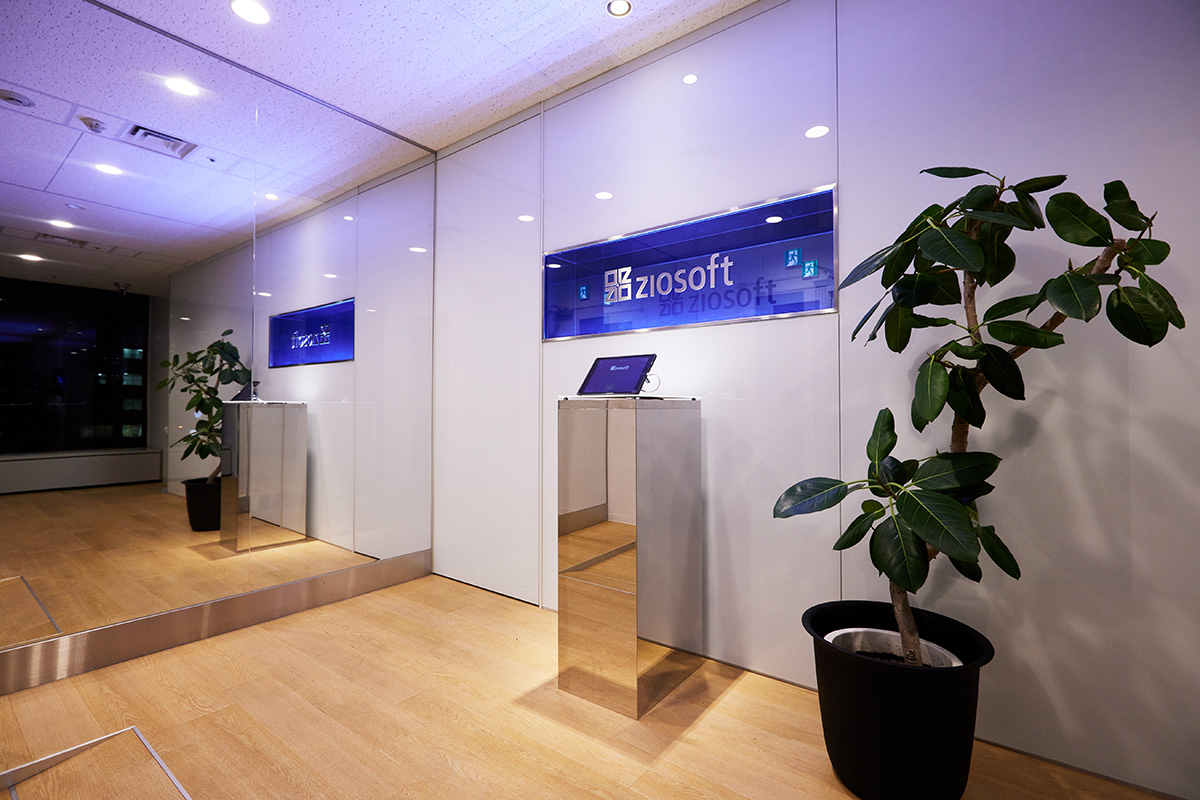
Ziosoft Tokyo Head office.
Of course, medical professionals are the ones you are targeting with your products, but could we ask a question from the patient’s point of view? In the case of your business, is the patient aspect something that you won’t showcase the benefits of your technology to? If so, how would you go about doing so?
At this moment in time, there aren’t connections there to push us to communicate extensively with customers or patients directly. Our main communication channels are through the doctors and medical professionals. It was interesting to see TV adverts for medication on US TV, and such advertisements would never exist in Japan. For myself and my company, I feel that the important thing is to maintain good communication with those medical personnel, not necessarily patients. They are the ones who will evaluate our products and spread the word about Ziosoft with their peers.
We know that you’ve attended many medical conferences around the world to discuss medical technologies. Where is the next conference you plan on attending?
As you said, we do attend many international conferences throughout the year, and some are coming up in San Antonio, Texas, and London I believe. In January next year, there is the Society of Cardiovascular Magnetic Resonance Conference 2024 in London. In March 2024 there is also the European Society of Radiology Conference in Vienna. Notably, we've been attending the annual meeting of the Radiology Society of North America for about 20 years.
Are you looking to open other offices in other regions around the world or are there any specific regions you believe have the most potential for your firm?
In terms of market size, the US is number one, with Europe being number two. We already have a presence in Japan, but if we look to other Asian countries where we do have high hopes for our presence. We are in discussions as to where to go next, and to that end, partnerships are quite important since they allow us to gather information and have a local presence in other markets. We are carefully considering our options.
What are your thoughts on the potential of the Indian market right now?
I think the market has huge potential right now since it is the world's largest population.
Imagine that we come back in five years and have this interview all over again. What goals or dreams would you like to have achieved by the time we come back for that new interview?
I've talked today about Ziosoft's technology regarding medical imaging and I think this is such a great technology to look more precisely at a patient, but even at the tail end of 2023, this technology has a lot to do still. I want to live in a world where doctors and professionals can get the most amount of information from medical imaging, something that will surely benefit radiologists, physicians, surgeons, and patients alike. I want to expand this application more on the clinical side. At the end of the day, the company was designed to make contributions to society, so expanding our applications is something that must exist within our company philosophy. If we can continue achieving this goal I will be very happy and proud of Ziosoft.
For more details, explore their website at https://www.zio.co.jp/en/
0 COMMENTS